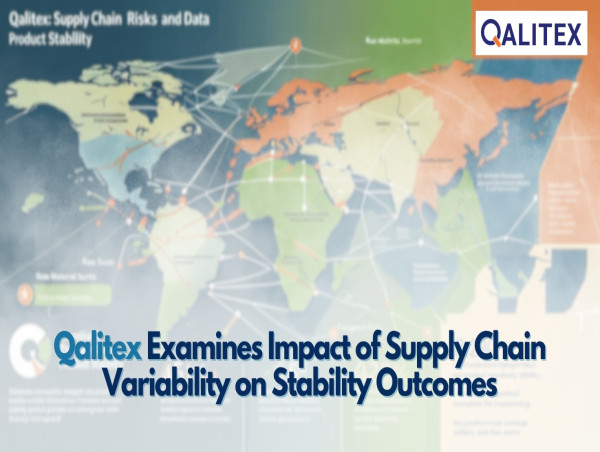As global brands continue to face shifting ingredient sourcing, variable transit conditions, and warehousing inconsistencies, Qalitex highlights how these fluctuations may undermine the integrity of shelf-life projections, even for formulations previously deemed stable under controlled conditions.
Traditionally, stability testing has been viewed as a laboratory-driven process, largely disconnected from the broader logistics lifecycle of a product. However, recent case assessments conducted by Qalitex indicate that growing supply chain variability—ranging from inconsistent raw material characteristics to prolonged shipping durations—can significantly alter how a product performs in real-world conditions.
This variability may lead to premature degradation of active ingredients, shifts in pH balance, microbial instability, or visual and olfactory changes that are not captured under controlled laboratory settings.
"Stability testing is only as reliable as the assumptions behind it," said Nour Abochama, Vice President for Operations at Qalitex. "When those assumptions no longer hold—because ingredients are arriving from different sources or shipments are exposed to extreme temperatures—then the original data set may not reflect actual shelf-life outcomes."
The Increasing Risk of Ingredient Inconsistency
Global ingredient sourcing practices have evolved in response to pandemic-era disruptions, geopolitical shifts, and cost pressures. As a result, many brands have expanded their supplier networks or substituted previously standardized inputs with alternative sources.
While these changes may preserve product availability, they also introduce measurable variability in ingredient composition. Even when meeting basic quality specifications, substitutions in excipients, carriers, or active components can subtly alter a product’s stability profile.
Qalitex Labs notes that ingredient lots from different suppliers often exhibit variations in moisture content, particle size distribution, microbial load, and oxidation sensitivity—all of which influence long-term product performance.
For supplements, deviations in botanical extract concentrations or encapsulated nutrient delivery mechanisms may trigger unexpected degradation pathways. In cosmetics, differences in emollient base quality or preservative efficacy can reduce microbial resistance over time, especially under suboptimal storage conditions.
Transit and Storage Conditions as Uncontrolled Stability Variables
Shipping delays, high-temperature container conditions, and inconsistent warehouse climate controls have also become stability stressors. Despite brands validating their products under International Council for Harmonisation (ICH) stability protocols, real-world transit conditions can exceed validated stress parameters.
Qalitex Labs reports an increase in stability deviation cases tied to temperature excursions during warehousing and transport, particularly during seasonal spikes. Products left on docks in humid environments or transported in non-refrigerated containers often arrive with early-stage instability markers.
In such scenarios, even well-formulated and fully compliant products may fail to meet expiration claims if real-world logistics introduce unaccounted-for stressors.
GMP Implications and Audit Readiness Concerns
The FDA’s current Good Manufacturing Practice (cGMP) regulations require firms to establish scientifically sound stability testing programs that demonstrate product quality over labeled shelf life. However, Qalitex warns that without factoring in supply chain realities, brands may find themselves out of alignment with FDA expectations—especially if consumer complaints or adverse events prompt inspections.
Moreover, private-label brands that source from contract manufacturers without direct control over ingredient procurement or transit practices may be particularly vulnerable. These brands often rely on blanket Certificates of Analysis (CoAs) or shelf-life claims that may not reflect specific logistical conditions tied to their product batches.
Qalitex likewise emphasizes that stability data should be treated as dynamic—not static—particularly when any component of the supply chain changes. Brands reformulating products, changing suppliers, altering packaging formats, or switching distribution methods should consider whether existing stability data remains valid under the new conditions.
"Scientific shelf-life validation isn’t just for the sake of meeting a requirement. It’s about understanding the entire product journey," Abochama added. "As that journey evolves, the testing strategy has to evolve with it."
This includes re-evaluating the packaging’s barrier properties under new transit scenarios, re-assessing microbial limits under longer holding periods, and documenting any ingredient substitutions with potential stability implications.
Global Market Expansion Compounds the Challenge
Brands exporting to multiple markets face another layer of complexity: climate zone variability. A formulation stable under ICH Zone II conditions (25°C/60% RH) may degrade faster under Zone IVb conditions (30°C/75% RH), common in Southeast Asia, the Middle East, or parts of Latin America.
Qalitex reports that companies expanding into new markets often overlook this variable, assuming their original stability data remains valid globally. However, regulators in certain jurisdictions now require zone-specific stability validation or robust justification based on climatic modeling.
In addition to regulatory risk, product degradation in warmer regions may lead to increased return rates, customer dissatisfaction, or loss of retailer confidence—particularly for beauty and wellness categories where sensory attributes are closely tied to consumer perception of quality.
Recommendations for Mitigating Stability Risks in Volatile Supply Chains
To help brands navigate these challenges, Qalitex Laboratories advises a proactive approach that integrates supply chain variability into both initial product validation and ongoing quality assurance. This includes:
Reviewing supplier variability and its potential impact on ingredient stability.
Implementing conditional re-testing protocols when sourcing changes occur.
Conducting shipping simulation studies that mimic worst-case transport conditions.
Adding interim stability checkpoints post-manufacture but pre-distribution.
Documenting all material changes for traceability in audits or investigations.
Where possible, Qalitex also encourages the use of real-time stability programs in parallel with accelerated protocols, especially for SKUs that are subject to frequent reformulations or logistic changes.
A Call for Cross-Functional Oversight of Stability Data Integrity
Qalitex notes that responsibility for shelf-life accuracy often falls solely on formulation or quality teams, without sufficient integration with procurement, logistics, or regulatory affairs. However, as supply chains become more complex, stability oversight must become a shared accountability across departments.
This includes establishing formal cross-functional review points whenever there are changes in sourcing, packaging, or distribution strategy—ensuring that stability implications are flagged and addressed before market release.
Qalitex’s Role in Supporting Scientific Shelf-Life Assurance Amid Ongoing Change
Qalitex Laboratories continues to monitor industry shifts affecting product stability, particularly where supply chain volatility intersects with regulatory and commercial risk. Its scientific testing services support brands in generating defensible, batch-specific data that reflects current formulations and distribution realities.
As part of its ongoing research and quality advisory work, Qalitex will continue to publish guidance and technical observations to help the dietary supplement and cosmetic industries align their stability practices with evolving conditions and expectations.
With this latest analysis, Qalitex reaffirms the critical need for brands to revisit and refresh their stability data when any part of the product lifecycle changes—ensuring that shelf-life claims remain valid, compliant, and scientifically supported.
Nour Abochama
Qalitex Laboratories
email us here
Visit us on social media:
LinkedIn
Instagram
Facebook
Legal Disclaimer:
EIN Presswire provides this news content "as is" without warranty of any kind. We do not accept any responsibility or liability for the accuracy, content, images, videos, licenses, completeness, legality, or reliability of the information contained in this article. If you have any complaints or copyright issues related to this article, kindly contact the author above.
![]()





